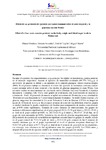Mostrar o rexistro simple do ítem
Efecto de un protocolo de ejercicio por cuatro semanas sobre el peso corporal y la glucemia en rata Wistar
| dc.contributor.author | Alcantar, Alcantar | |
| dc.contributor.author | Trujillo, Xóchitl | |
| dc.contributor.author | Huerta, Miguel | |
| dc.date.accessioned | 2019-04-29T12:17:04Z | |
| dc.date.available | 2019-04-29T12:17:04Z | |
| dc.date.issued | 2017 | |
| dc.identifier.citation | Sportis, 2017, 3 (3):471-485 ISSN: 2386-8333 | es_ES |
| dc.identifier.issn | 2386-8333 | |
| dc.identifier.uri | http://hdl.handle.net/2183/22784 | |
| dc.description.abstract | [Resumen] Durante el ejercicio, los requerimientos de glucosa por los tejidos se incrementan, particularmente en el músculo esquelético; durante el ejercicio de intensidad moderada (60-75% VO2máx); el incremento de glucosa es debido a un aumento en la relación glucagon venoso-insulina (Engler 2006). En el presente trabajo se determinó el efecto del ejercicio de resistencia aeróbica durante cuatro semanas sobre el peso corporal y los niveles de glucosa sanguínea en ratas Wistar. Los animales recibieron entrenamiento en una banda sinfín (Modular Enclosed Treadmill; Columbus Instrument, Columbus, OH, USA), cero grados de inclinación, con incorporación de dispositivo eléctrico de 10 mV. El protocolo de marcha se aplicó en sesiones de 30 min/día, a una velocidad de 10 m/min con una frecuencia de 5 veces/semana durante 4 semanas. Se midió el peso corporal y la glucosa sanguínea. Se determinó la Curva de Tolerancia Oral a la Glucosa (CTOG) en sangre en ayuno de 12 horas al inicio y al fin de cuatro semanas de ejercicio. La diferencia entre los grupos se analizó mediante la prueba estadística t de Student para comparación de medias, considerando una p≤0.05 como significativa. Después de cuatro semanas de entrenamiento, los grupos no mostraron diferencias significativas en el peso corporal 262.0±31.78 g al inicio y 292.01±35.62 g al final en el grupo control (p>0.05) vs. 282.75±25.91 g al inicio y 301.47±31.38 al final en el grupo de ratas entrenadas (p>0.05). Asimismo, los niveles de glucosa sanguínea antes y después del protocolo de ejercicio no se modificaron significativamente entre los grupos de estudio, siendo en el grupo control de 73.5±3.8 g/dL al inicio y 83.5±2.38 g/dL después de las 4 semanas de estudio; mientras que en el grupo experimental el nivel de glucosa sanguíneo disminuyó de 91.0±7.43 g/dL al inicio a 85.7±7.0 g/dL al final de las 4 semanas del protocolo de entrenamiento; sin embargo, esta diferencia no fue significativa entre los grupos (p>0.05). La CTOG antes y después del protocolo de ejercicio tendió a ser similar en ambos grupos de estudio | es_ES |
| dc.description.abstract | [Abstract] Tissue glucose requirements augment during exercise, particularly in skeletal muscle. Glucose levels rise during moderate intensity exercise (60-75% VO2máx) due to an increase in the glucagon-insulin relationship (Engler, 2006). In this study we determined the effect of aerobic resistance exercise during four weeks on the body weight and blood sugar levels of Wistar rats. Experimental animals received training in a treadmill (Modular Enclosed Treadmill; Columbus Instrument, Columbus, OH, USA) with zero degrees of inclination and a 10 mV electric device incorporated. The exercise protocol was applied in 30 min sessions per day at a velocity of 10 m/min. with a frequency of 5 times a week for 4 weeks. Body weights and blood sugar levels were measured. At 12 hour fasting oral glucose tolerance curve (OGTC) was performed before and after the 4 weeks of exercise. The differences between the groups were analyzed using Student´s t tests, a p ≤ 0.05 was considered significant. After 4 weeks of training, the groups showed no significant differences in their body weights 262.0 ± 31.78 at the beginning, and 292.01 ± 35.62 g at the end of 4 weeks in the control group vs. 282.75 ± 25.91 g at the beginning, and 301.47 ± 31.38 g at the end of 4 weeks in the trained rats; p > 0.05). Similarly, blood glucose levels before and after 4 weeks of application of the exercise protocol were not significantly modified between the groups (73.5 ± 3.8 and 83.5 ± 2.38 g/dL in control group vs. 91.0 ± 7.43 and 85.7 ± 7.0 g/dL in the trained animals; p > 0.05). Likewise, the OGTC was comparable in both groups, before and after the application of the exercise protocol. | es_ES |
| dc.language.iso | spa | es_ES |
| dc.publisher | Universidade da Coruña | es_ES |
| dc.rights | Atribución-NoComercial-SinDerivadas 3.0 España | es_ES |
| dc.rights.uri | http://creativecommons.org/licenses/by-nc-nd/3.0/es/ | * |
| dc.subject | Ejercicio de resistencia | es_ES |
| dc.subject | Glucosa sanguínea | es_ES |
| dc.subject | Peso corporal | es_ES |
| dc.subject | Ratas Wistar | es_ES |
| dc.subject | Resistance exercise | es_ES |
| dc.subject | Blood glucose | es_ES |
| dc.subject | Body weight | es_ES |
| dc.subject | Wistar rat | es_ES |
| dc.title | Efecto de un protocolo de ejercicio por cuatro semanas sobre el peso corporal y la glucemia en rata Wistar | es_ES |
| dc.title.alternative | Effect of a four-week exercise protocol on the body weight and blood sugar levels in Wistar rats | es_ES |
| dc.type | info:eu-repo/semantics/article | es_ES |
| dc.rights.access | info:eu-repo/semantics/openAccess | es_ES |
| UDC.journalTitle | Sportis | es_ES |
| UDC.volume | 3 | es_ES |
| UDC.issue | 3 | es_ES |
| UDC.startPage | 471 | es_ES |
| UDC.endPage | 485 | es_ES |
| dc.identifier.doi | https://doi.org/10.17979/sportis.2017.3.3.1825 |






